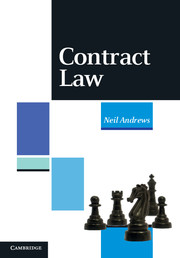Book contents
- Frontmatter
- Contents
- Preface
- Table of cases
- Table of statutes
- Table of statutory instruments
- Part I Introduction
- Part II Formation
- Part III Consideration and intent to create legal relations
- Part IV Third parties and assignment
- Part V Vitiating elements
- 9 Misrepresentation
- 10 Mistake
- 11 Duress, undue influence and unconscionability
- Part VI Terms and interpretation
- Part VII Breakdown and liability
- Part VIII Remedies for breach
- Part IX Illegality and public policy
- Part X The future
- Appendix: A who's who of contract law
- Bibliography
- Index
11 - Duress, undue influence and unconscionability
from Part V - Vitiating elements
- Frontmatter
- Contents
- Preface
- Table of cases
- Table of statutes
- Table of statutory instruments
- Part I Introduction
- Part II Formation
- Part III Consideration and intent to create legal relations
- Part IV Third parties and assignment
- Part V Vitiating elements
- 9 Misrepresentation
- 10 Mistake
- 11 Duress, undue influence and unconscionability
- Part VI Terms and interpretation
- Part VII Breakdown and liability
- Part VIII Remedies for breach
- Part IX Illegality and public policy
- Part X The future
- Appendix: A who's who of contract law
- Bibliography
- Index
Summary
INTRODUCTION
Summary of main points
(1) Duress. This involves the application of illegitimate pressure so that the relevant contract or contractual modification is unsafe and should be set aside. The pressure will normally take the form of a threatened legal wrong (crime, tort, breach of contract, etc.). Exceptionally, it might be the threat of a lawful act (such as reporting a person to the police or some other authority). In the latter type of case, the court might regard the threat as ‘illegitimate’, that is, an unacceptable or morally reprehensible use of pressure; but this can only involve a value judgement because, ex hypothesi, the threat was not to break the law.
(2) Undue influence. This is an equitable doctrine. ‘Actual undue influence’ is broader than coercion, although it can take the form of coercion. If actual undue influence is shown, there is no need to show that the transaction is objectively ‘unfair’ and ‘unbalanced’. However, the more common situation is that undue influence involves abuse of a relationship by someone occupying a superior or dominant position. Plainly, unequal relationships include solicitor/client, teacher/pupil, spiritual advisor/follower, trustee/beneficiary. Here, the law acknowledges that the danger of abuse exists. To this extent, the law speaks of ‘presumed undue influence’. In other situations, the claimant must show that, on the particular facts of the case, he ‘looked up to’ and so placed ‘trust and confidence’ in the other.
[…]
- Type
- Chapter
- Information
- Contract Law , pp. 306 - 342Publisher: Cambridge University PressPrint publication year: 2011



